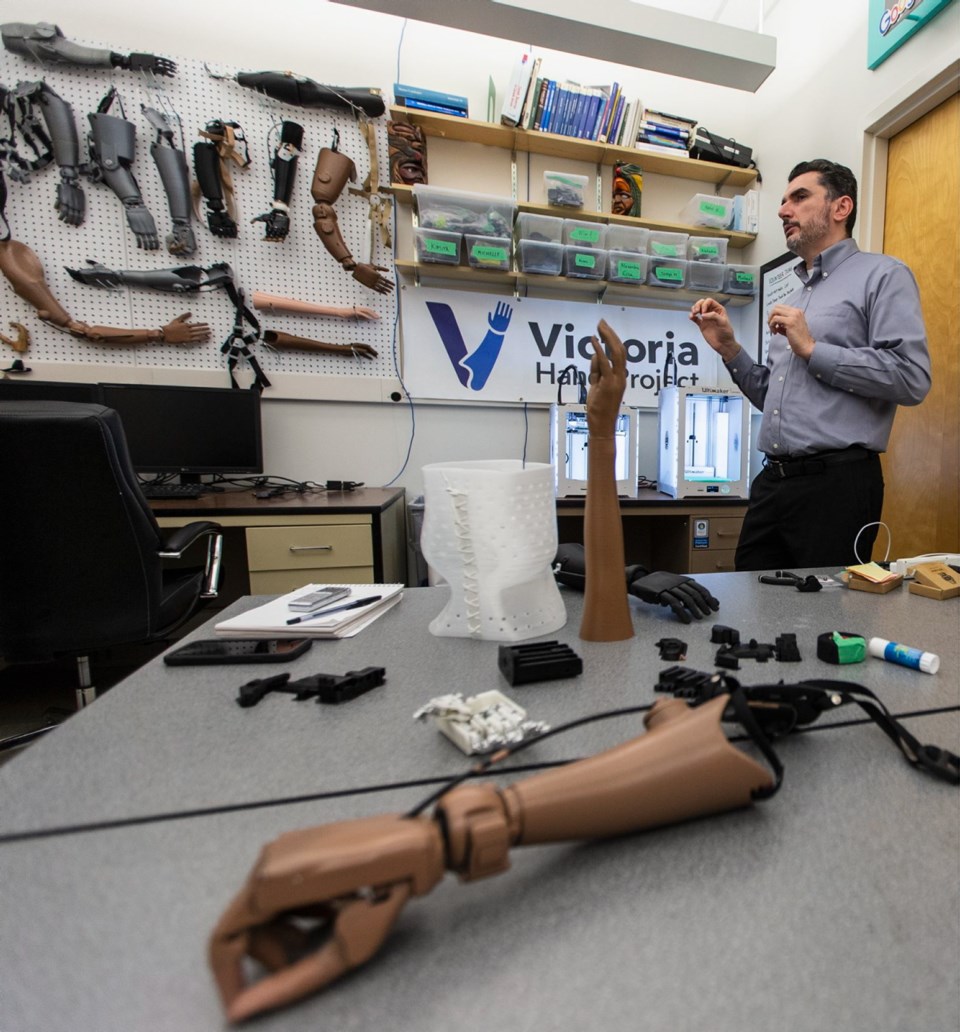A $1-million injection of funding will allow the UVic-based Victoria Hand Project, which manufactures low-cost prosthetics for the developing world, to expand and develop a new low-cost project for communities in North America.
The project, which has been using 3-D printers to manufacture low-cost prosthetic hands since 2015, has received a large grant from the TD Ready Challenge.
The money will allow Victoria Hand Project to develop custom-fit, low-cost scoliosis braces and low-cost prosthetics for amputees in underserved communities in Canada and the U.S.
It’s a huge boost for the project that will change people’s lives while enhancing learning for students at the University of Victoria, said Nick Dechev, executive director of the project and acting chair of the university’s department of mechanical engineering.
“Our mission is to help the most under-served people in North America and remote communities,” he said.
The money comes from the TD Ready Challenge, an annual North American initiative that offers $1 million in grants to fund innovative solutions for problem sectors.
This year’s challenge offered as many as 10 $1-million grants to help improve access to early detection and intervention for diseases.
The funding will go a long way to expand the scoliosis-brace project Dechev and his team started working on in 2016. Dechev said they saw an opportunity to manufacture braces to help correct curvature of the spine, using the same 3-D printing process they use for prosthetic limbs.
“About three per cent of kids anywhere in the world have scoliosis, and of those, 10 per cent need bracing. That means three per 1,000 kids in Canada and the U.S. have backs that are crooked to the extent they need corrective braces,” he said, noting the cost of bracing is not covered in Canada.
“And in the U.S., it’s worse, unless you’re insured.”
The cost of a brace can be up to $5,000, while the 3-D printed version can be made for about $150 in materials, though it would have a retail cost of about $1,000.
Chief operating officer Michael Peirone said the grant money will cover setting up seven print centres across North America and the initial printing of 200 prosthetic hands and 160 scoliosis braces.
“Once these print centres are set up, they can continue to print braces beyond the funding of the grant,” he said.
The funding will also allow them to print custom-fitted prosthetic limbs for underserved people in North America. The cost of a 3-D printed limb is about $100, compared to non 3-D limbs that can range from $2,500 to $10,000, depending on their customization and the material used.
Dechev said students stand to win with the new funding. “It means a lot of learning opportunities,” he said, noting teams of students and designers have devoted well over 12,000 hours to honing the design of the prosthetic limbs alone. “This means we can engage with a lot more students and it gets them some real-life experience.”
Over the last two years, the Victoria Hand Project has manufactured 130 prosthetic limbs for people around the world. They now have partners in seven countries, including Guatemala, Haiti, Ecuador, Egypt, Cambodia, Uganda and Nepal.
The project, funded by UVic with a series of grants — they won a $250,000 Impact Challenge grant from Google in 2017, for example — sets teams up in each of the countries with the technology to scan, print and fit people with prosthetics.
“Cost is everything to us — the cheaper you can make it, the wider the reach,” said Dechev, adding that in many of these countries, $20 is hard for most people to come up with, let alone $300 — the retail price of a 3-D printed prosthetic. “This is a charity … the reality is the people we are serving have next to nothing.”
Peirone said seeing the final result — someone who has been without a hand actually getting to use one for the first time — is hard to describe.
“When you go to some of these countries, when you work with some of these people and see how their lives are changed and how happy they are, it’s very rewarding,” he said.



